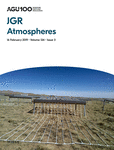Emission Characteristics of Primary Brown Carbon Absorption From Biomass and Coal Burning: Development of an Optical Emission Inventory for China

Share this post on: Twitter Facebook
Brown carbon (BrC) affects the Earth’s radiative balance due to its strong light absorption at short wavelengths. A custom‐made combustion chamber was used to simulate biomass and coal burning and to investigate the emission characteristics of BrC absorption. Absorption Ångström exponents (AAEs) at the wavelength pair of 370 and 880 nm ranged from 1.19 to 3.25, suggesting the possible existence of BrC in biomass‐ and coal‐burning emissions. Based on the assumption that AAEBC = 1.0, BrC from biomass burning contributed to 41–85% of the total particles light absorption at 370 nm, which is much higher than that from coal burning (15–18%). The estimated absorption emission factors of BrC at 370 nm for biomass and coal burning were 15–47 and 2–13 m2/kg, respectively. A 10 × 10 km gridded BrC optical emission inventory for biomass and coal burning in China for 2015 was developed based on the measured absorption emission factors of BrC values and high‐resolution activity data. The total annual BrC absorption cross section emissions from biomass and residential coal burning were 4,194 Gm2 (relative uncertainty at the 95% confidence level of −33.2, 41.2%) and 615 Gm2 (−39.3, 40.1%), respectively. These results should be useful for improving estimates of the radiative effects of BrC in China.
Published online: 21 January 2019
Copyright © 2019 American Geophysical Union. | All rights reserved.
Appear in JGR Atmospheres, Volume 124, Issue 3
Authors: Jie Tian, Qiyuan Wang, Haiyan Ni, Meng Wang, Yaqing Zhou, Yongming Han, Zhenxing Shen, Siwatt Pongpiachan, Ningning Zhang, Zhuzi Zhao, Qian Zhang Yue Zhang Xin Long Junji Cao